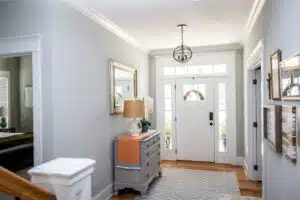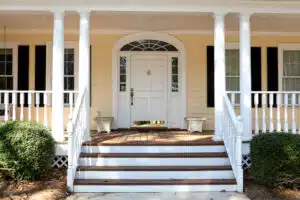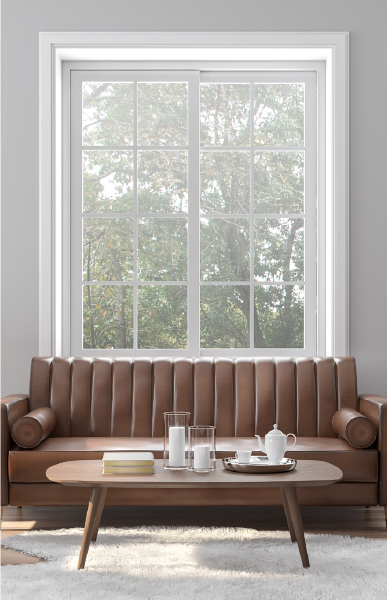Today we’ll answer all your FAQs about what transom windows are, where transom windows are installed, and more!
Have you ever spotted a small decorative window above someone’s front door and thought, “Huh, what a strange little window. That must be an old house.”
Congratulations, you’ve spotted a transom window in the wild!
And while transom windows are the marker of many Victorian and Tudor homes, they’re also having a major comeback in modern housing design. But what exactly is a transom window? And what do they do?
Read on for the answers to all of your most pressing transom window FAQs.
What is a transom window?
Transom windows are small windows that sit on top of an existing window or door’s transom (aka their top beam)—hence, the name.
Need a review of common window vocabulary? Consult our handy guide!
Transom windows have a long history in architecture, dating back to ancient Rome where they were propped open for ventilation in bathhouses and public buildings. In the Middle Ages, they were popular in churches and cathedrals, often featuring intricately stained glass designs. During the Renaissance, transom windows became more common in domestic architecture.
More recently, plenty of 19th-century commercial architecture featured transom windows to provide ventilation in public buildings like banks and offices. They would often hinge open at the top or bottom and could be operated with a long pole arm.
With the invention of AC and climate control, transom windows for practical purposes fell into decline. However, in recent years there’s been a resurgence of interest in transom windows as a design feature in contemporary architecture. Some architects incorporate sealed and operable transom windows into their designs as a way to bring in more natural light, increase ventilation, and add visual interest to a space.
Where can transom windows go?
Transom windows can go anywhere in your home! In contemporary building design, you can find transom windows in the traditional locations—above the front doors and windows—but you can also find them:
- In the bathroom: Transom windows can be found in plenty of modern bathrooms, especially in showers. Their size, elevated placement, and glass options allow for an influx of natural light without compromising privacy.
- Over hallway doors: Darker homes can use transoms to create a more open feel and connect rooms.
- In sunrooms: Sunrooms primarily utilize larger windows, but transom windows can add a beautiful and unique quality to otherwise uniform walls of windows.
- In kitchens: Kitchens often struggle with the balance between light, accessible openings, and limited wall space. The right transom design can revolutionize a kitchen looking for an attractive but unobtrusive window.
What are the benefits of transom windows?
Transom windows may seem small and insignificant, but they can play a huge role in brightening and enriching your home’s overall aesthetic.
These unique windows are great for providing natural light to a room without sacrificing privacy because they are often small and placed high up. This is especially useful in bathrooms and showers where open windows might compromise modesty.
Additionally, if you install interior, openable transom windows, you can regulate airflow between rooms while still being able to close doors and guard your space from wandering pets, kids, or guests.
Finally, transom windows are a gorgeous home renovation option at an affordable price. If you want to spruce up a doorway or window area and you can’t afford an expensive project, adding a transom window is a beautiful and functional upgrade at a fraction of the cost.
Do transom windows open?
Nowadays, transom windows usually do not open. While historic transom windows were designed for airflow before the invention of air conditioning, they now serve a primarily decorative purpose. But don’t let that dissuade you! If you’re dead-set on a transom window that opens, you can absolutely install one. However, since modern homes offer other points of airflow with much easier access, there’s generally no need to install an opening system for your transom window(s).
Do transom windows only come in one shape?
Transom windows come in multiple shapes. Unlike some other window styles defined by their shape—such as bay windows—transom windows are defined by their location. If you have a small window above a door or another window, it’s a transom window no matter what it looks like. That means you can have a rectangular, circular, or arched transom.
The most common transom window shapes are semi-circle and rectangle.
How do you decorate a transom window?
Decorating a transom window can get tricky depending on its location. If you can easily reach your transom window and you have the wall space, you can always add a window treatment of your choice for an aesthetic flair. However, transom windows frequently live in high-up spaces where curtains of any kind would only be a burden.
If you want to spruce up your transom window, one of the best ways is to replace the clear or frosted glass with stained or colored glass. Since transom windows rarely open, stained glass is a safe option that adds a personal touch.
How do you block light from a transom window?
Blocking light from a transom window isn’t always an easy process, especially if the window is very high up. If your transom window is low enough to reach, any light-blocking window treatment will do the job. However, if your transom is so high that curtains would only increase your frustrations, your best bets are either motorized shades or frosted glass.
Motorized shades can be controlled with a remote from the ground, making it easy to block the light coming from your transom window. However, installing motorized shades isn’t always cheap.
Frosted glass is a clouded glass that lets light through, but blurs the light more than standard glass. It also adds a touch of privacy if your transom happens to be in a shower across from a neighboring window.
Are transom windows expensive?
Transom windows are not expensive. In fact, they boast some of the cheapest prices of any window design with costs ranging from $120-$270 per window. That price doesn’t take labor or potential structural altering into account, but if you’re strictly looking at window cost, transoms are about as cheap as windows get. That makes transom windows an affordable option for home improvements.
How do you install a transom window?
Unless you’re a trained professional, the answer to, “How do you install a transom window?” is “You don’t.”
While any window installation DIY comes with risks, transom windows can be the most deceptively tricky of all. Because these windows usually sit high up and on top of other openings, the safest option is to call an expert at Window Nation.
At Window Nation, we’re here to help no matter where you are in your replacement or installation process. If you have a transom window project on the horizon, our experts are happy to consult, plan, and install your ideal design.
Contact Window Nation today for friendly expert guidance and a free quote.




